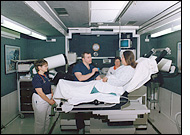Lithotripsy is a technique used to break up stones that form in the kidney,
bladder, ureters or gallbladder. Stones can cause obstruction, infection, prolonged
bleeding or serious bleeding. There are several ways to remove these stones,
although the most common is extracorporeal shock wave lithotripsy.
The shock waves are focused on the kidney stone and break the stone into tiny
pieces, which are passed out of the body naturally during urination. Throughout
the procedure, the doctor can view what is happening to the stones through
x-ray or ultrasound monitoring.
This procedure prevents you from having to undergo surgery to have the stones
removed which reduces discomfort, complications, hospital stay, costs and recovery
time. Lithotripsy can cause mild discomfort so a mild sedative
or painkiller is usually given beforehand. Depending on your level of sedation,
you may feel a tapping sensation when the procedure begins.
 |
You will need to have routine blood and urine tests, x-rays and
possibly an electrocardiogram before the procedure. X-rays will help the doctor
determine if other treatment options or other treatments combined with lithotripsy
are preferable because of the size, location or number of stones. Your urine
may also be tested to exclude an infection, which will have to be treated prior
to lithotripsy. |
You will usually be asked not to drink or eat anything for 6 hours prior to
the procedure, or after midnight of the previous night if the procedure is
in the morning. If you take regular medication, you should ask your doctor
if they are safe to take before the procedure. For instance, you may be asked
to stop taking aspirin and other drugs that interfere with blood clotting several
days before.
On the day of the procedure, you should wear comfortable clothes that are
easy to remove, as you will have to change into a surgical gown. The procedure
generally takes from 45 minutes to 1 hour. In most cases, you will be asked
to lie on a table on top of a soft cushion, through which the shock waves are
directed from the lithotripsy machine, called the lithotripter.
Extracorporeal shock wave lithotripsy is a very safe procedure with few complications.
However, minor complications do occur:
- For kidney stones, bleeding may occur around the kidney and in some rare
instances, this may require a blood transfusion.
- Sometimes, when kidney and urinary tract stone fragments are being passed,
urine flow from the kidney can be blocked. If this causes severe pain or
blockage of the kidney, a tube may be placed through the back and into the
kidney to keep the kidney drained until all the fragments pass out.
- Stone fragments are occasionally left in the body. This means that additional
treatments are needed.
Note: An excessive urge to urinate, excessive blood
in the urine, extreme pain or other unusual symptoms may indicate an infection
or a blockage. If any of these symptoms occur, you must contact your doctor
immediately.
You should tell your doctor if you could be pregnant, because lithotripsy
must not be performed during pregnancy.
While most kidney stones are treated with this type of lithotripsy, not all
stones can be treated this way. Sometimes a laser is used to pulverize the
stone, but when a laser is used, the doctor must use an endoscope, which is
a tube introduced into the body through the urinary tract to get close to the
stone.
The doctor may also access the stone from your back into your kidney, through
a procedure called percutaneous lithotripsy. Laser lithotripsy is usually used
when the stone does not respond to extracorporeal shock wave treatment or when
it is in a place that is difficult to access. It requires a hospital stay and
carries a slightly greater risk of complications than extracorporeal shock
wave lithotripsy.
After the treatment, patients usually remain in the recovery room for one
and a half to two hours and are then discharged. You should go home and rest
after discharge from the hospital, rather than attempting to get back into
your daily routine. It is extremely important that you have someone
drive you home from the hospital. Most people can return to normal
daily activities within one or two days.
For kidney and other urinary stones, it is recommended that you drink plenty
of water in the weeks following the treatment, to help you to pass the stone
fragments and prevent a recurrence. You may experience pain and nausea when
the fragments pass, which begins soon after treatment and may last for up to
four to eight weeks. Taking a painkiller and drinking lots of water will help
relieve symptoms. It is normal to have a small amount of blood in your urine
for a few days to weeks after the procedure.
Depending on the type of lithotripsy, you may need antibiotics and anti-inflammatory
medicines for a few days. If the stones are in your urinary system, you will
probably be asked to strain your urine at home so any stones that are found
can be sent to the lab for examination.
You will be asked to visit your doctor for a follow-up appointment in the
weeks following the lithotripsy. (For example, this might include a kidney
x-ray to determine if kidney stones are still present).
About 70 to 90 percent of patients who are good candidates for this treatment
are found to be free of stones within a few months of treatment.

